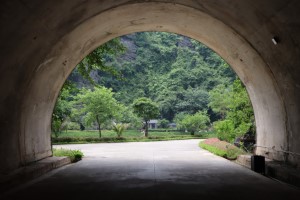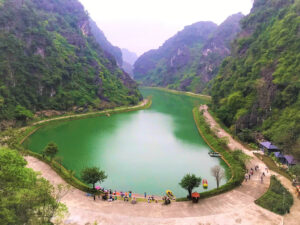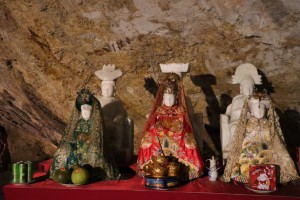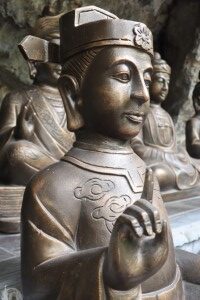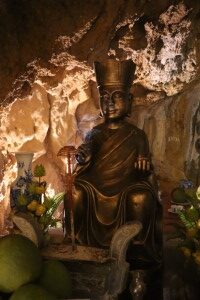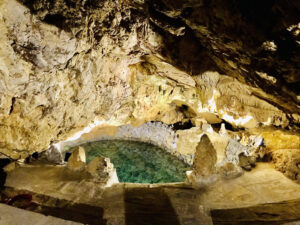Am Tiên cave, lake and the pagoda is a popular excursion for both domestic and international tourists. With beautifully sculptured gardens, wide foot paths, a couple of coffee/souvenir shops, plenty of niches for those all important selfie shots and bicycle hire all wrapped around a natural mountain lake, it is a very cool and relaxing destination.
However, it was not always this way. Originally, Am Tien was only accessible via an arduous climb of 205 stone steps over a steep cliff and even then guarded over with two impressive Watch Houses. These days two new tunnels have been excavated through the living rock to make access easier.
Like Thung Lau, the “cave” here not only refers to the very real grotto in the main pagoda but includes the valley itself. Until recently Am Tien was literally a “hidden valley” surrounded on all sides by an array of almost impenetrable karst cliffs. This natural barrier provided protection and safety to those who knew the secret path. Hidden, with narrow entry points that were easily defended, these insular valleys were likened to open air caves.
For the intrepid, the original entrance is diagonally opposite the Dinh – Le temples east gate on Trang An street, with another, almost forgotten entrance at the oppoiste end. However, entry via “old” paths is still difficult and the iron Watch house gates mostly locked. Much better to use the new tunnels with their accompanying car parks that have opened up Am Tien to the modern world.
Visiting Am Tien
Early morning is an excellent time to visit. Even if overcast or covered in fog, the temple fuses with the cloud draped karst mountains and settles in a fine mist over the large green lake. Edged with water plants and lilies that bloom beautifully on the surface, the water reflects the vibrant mountain background and makes it a perfect place for contemplation and relaxation.
A popular excursion is to walk around the modern paved path that surrounds the lake. The leisurely walk is a favorite of families and young people who come here for the spectacular setting and to soak in the medieval atmosphere. Caretakers also maintain many gardens filled with Bodhi trees and flower beds bursting with petunias, moss roses, and yellow daisies, all used to decorate the temple.
The lake is generally clear and with a little luck you will also get to see large goldfish and Koi as well as Tổng Trường (Climbing Perch), the delicious specialty of this limestone edged water valley. For a bit of fun, packets of fish meal are available to buy at the kiosk and feeding the fish is a popular activity. Swimming, however is strictly forbidden.
The architects took advantage of the majestic mountain terrain by constructing the previously mentioned watch houses between the ravines at each end of the valley. These structures are accessible to the general public – at least from within the park.To the grotto itself requires a brisk walk up a 200+ step stairwell. Although not a difficult or arduous climb,in the summer and on hot days it can feel that way. Just remember that there are those cafe below that sell chilled water, cool drinks and ice cream to reward you after your efforts!
The Dragon Cave
The cave is said to be in the shape of the mouth of a Dragon, perhaps the most prominent creature in Vietnamese mythological culture. So it is not surprising that locals sometimes call the grotto “the Dragon cave”. Inside the entrance is a row of shrines that fill the underground space of nearly 100 square meters. Built as a place to worship Buddha, it also venerates the mandarins and generals who helped build the Dinh dynasty and the Mother Goddesses of Vietnamese folk religion. A mixed collection that reflects the diversity of Vietnamese religions. Of particular note are the Buddhist and Mother Goddess statues as they are made from monolithic chunks of precious white jade.
Am Tiên is also remembered as the place where Queen Duong Van Nga chose to spend her later years in homage and meditation. This legendary Queen was central to the first two centralized feudal dynasties of Vietnam and played a vital role in the transfer of power from the Dinh (968-980) to the Tien Le (980-1009) dynasties. Queen Duong Van Nga is sometimes called the mother of ancient Vietnam and herself is often revered as a goddess.
Spirituality
Like other cave structures in Ninh Binh-Hoa Lu, Am Tien cave contains many stalagmites/stalactites formed through thousands of years of the natural process of water and limestone erosion. These beautiful natural objects are often imbued with supernatural aspects and are imagined as Buddha fruit, lotus flowers, historical figures, animals and mythical characters.
Visitors should be careful of the slippery floor when entering the cave due to the continual seepage that created the cave in the first place. As visitors continue deeper into the pagoda complex, there are many impressive worshiping altars, including a small well at the rear. Legend has it that anyone who reaches the “green jade well” in Am Tien cave will have their grievances addressed, whether those grievances are in their soul or through misunderstandings in their daily lives.
According to legend, King Dinh Tien Hoang, the founder of the Dinh Dynasty (924-979) originally used the cave to confine tigers and leopards. It also serveed as a prison for miscreants and traitors. Local lore says that for those deemed deserving of capital punishment, the green waters below teemed with poisonous snakes and crocodiles, and authorities threw the guilty into the water. It also tells that those who survived this bizarre punishment earned their exoneration.
History
The first king of the Ly Dynasty (1009-1225) moved the capital from Hoa Lu to Thang Long (Hanoi) in 1010. However, the local citizens believed there was still much resentment from the “ghosts” of the victims of the earlier dynasties. The local people built altars and burned incense to drive out these lingering specters and encourage them to depart and enter reincarnation..
During the Ly Dynasty, Buddhism flourished in Vietnam and many Confucian temples also became places for those who wanted to learn about Buddhism and find enlightenment.
Saint Nguyen Minh Khong (1065-1141) was a famous Buddhist resident here, preaching and expanding the Buddha altars in the cave. Many of the Saint’s effort were towards absolving the souls of the unfortunates who died here, to help their spirits rise to heaven. The main cave displays statues of both Buddha and the Holy Saint Nguyen Minh Khong, and perhaps we can judge his success by the peaceful and serene environment that Am Tien offers today.
Magic in the Mountains
Many debates surround the interpretation of the various names given to the majestic mountain scenery here. Young people in particular associate it with a historically famous love affair between Ngo Nhat Khanh and the daughter of Dinh Tien Hoang, Phat Kim and call the lake ‘Tuyệt Tình Cốc (the Great Love Cup). Others argue the name comes from the purity of the “green jade well” inside the mountain grotto. Either way, young couples in love often visit this romantic spot.
Regardless of the legends, nature itself grants Am Tiên a special magic. Standing at the entrance of Am Tiên and looking down, one can experience the true beauty of this most ancient place. Particularly at sunrise when the sun rises high through a light fog, clearing the air and revealing the mountains and the lake below. In this moment, the centuries seem to fall away, as if you’re wandering through a forest full of spirits or living in a time when elves and dragons roamed the ancient Vietnamese countryside.
Now a tranquil and scenic spot, many visitors today come to Am Tiên just to relax, picnic, contemplate and soak up the atmosphere. As mentioned, the lake has a long sealed pathway around its perimeter, surrounded on one side by majestic limestone cliffs and by the shimmering green lake on the other. Besides hiding the valley from unsuspecting enemies, the mountains and lake have traditionally kept the valley at a relatively even temperature year round, making it perfect for long meandering strolls any time of the year.
Travel Tips
Directions to Am Tiên cave and pagoda are straight forward. From Trang An gate, follow Trang An main street for around 10 km where there is a sign for the cave (Dong Am Tien) on the right. Make the turn and continue for another 500m. As Am Tiên is quite far from other Hoa Lu Ancient City sites, it may be difficult to find a return transport. Visitors who do not self-drive or join a tour should book their return journey in advance. A visit to the site usually takes about an hour, while a more leisurely one could last two or more hours.
The admission fee to Am Tiên cave and pagoda is 50,000 VND per person and there is a parking fee of 10,000 VND per motorbike and 50,000 VND per car. Bicycle rental is available during peak periods for visitors to cycle around the lake within the temple grounds. You can also rent children’s bicycles for 40,000 VND and adult bicycles for 50,000 VND.

